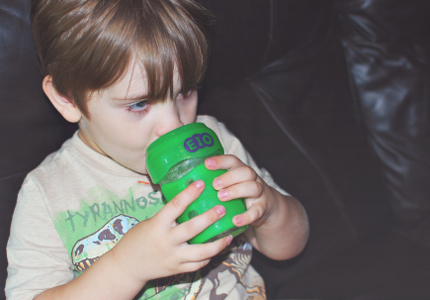How to Transition From Bottle to Sippy Cup
3 min read
A sippy cup is more similar to a bottle than an open cup, making it easier for babies who have been exclusively breastfed or bottle-fed to adjust. While some parents worry that sippy cups might increase the risk of tooth decay and other dental issues due to recent concerns, this is typically only a problem for children who carry them around filled with juice or milk all day. Besides, parents who go directly from bottles to cups often have to spend a lot more time teaching their children how to use them and they also have to deal with more messes and laundry. Sippy cups are practically spill-proof which means that, as a busy parent, you won’t have to spend your time dealing with unexpected messes. This is why it’s important to know when to use a sippy cup and how to help your little one transition to it.
Get a Sippy Cup That’s Easy To Use
Don’t choose a sippy cup based on how it looks – some of the cutest cups are difficult for babies to use or they leak constantly. The best sippy cups are designed to be easy for babies to use – they have handles that your baby can comfortably grasp and a textured surface to help improve their grip. You can also choose a sippy cup with a soft spout as it will feel more like a bottle nipple so your child is more likely to accept it. The reason that we use sippy cups for our kids is to help them transition from sucking from a bottle to sipping from a cup. Many sippy cups have a spill-preventing valve to prevent messes. Unfortunately, this also defeats the purpose of a sippy cup because the valve makes them suck and not sip, so avoid these cups. Instead, get a sippy cup that is leak-proof and weighted on the bottom so that it won’t tip over as easily.
Don’t Fill It up Right Away
The first time that your child sees a sippy cup, they will be fascinated by, what seems to be, their new toy! Even though they don’t know how to use it as of yet, it’s important that they get the chance to satiate their curiosity about this new object before they start using it. You can gently show them how to hold it even if it’s empty, just so they get used to it. If possible, do this every morning for a few days, around the time that they have a feed.
Start With Favorites
When you fill your baby’s sippy cup for the first time, go with familiar fluids, especially ones that they love. According to guidelines by the AAP (American Academy of Pediatrics), breast milk and formula are good options for the first couple of times so that your little one gets used to the sipping action. After that, you should switch to water so that they can use it multiple times a day without the risk of any dental issues.
Celebrate Success
It can take several days of trial and error for your baby to learn to use their sippy cup so stay calm and be patient. Apply some of the milk or formula onto the straw or spout of the cup to encourage your little one to take a sip. Celebrate success with plenty of praise and if possible, get the family to join in the celebration. Positive reinforcement works very well with babies and toddlers and is very effective in helping them try out and learn new things. If your child is in daycare, inform their daycare providers so that they can follow the same routine to maintain consistency.
You Can Start Around 4-6 Months Old
As a general rule of thumb, by the time babies are six months old, their motor skills have developed sufficiently that they can use a sippy cup. However, every child is unique and some kids may be ready at four months while others might only be ready at eight months. This is why medical researchers recommend that you pay attention to your baby’s cues for cup readiness. For instance, if your baby is able to sit independently, holds objects with both hands and brings them to their mouth, you know that your little one is ready for a sippy cup.






